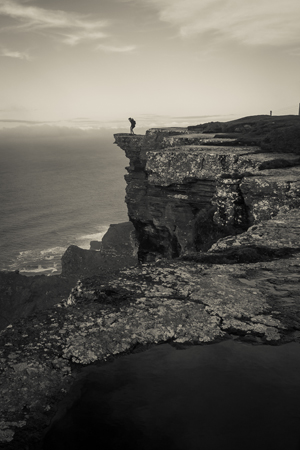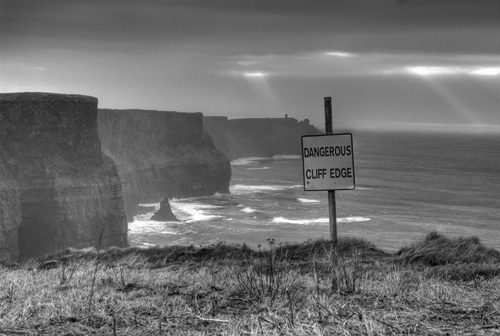
Your complimentary articles
You’ve read one of your four complimentary articles for this month.
You can read four articles free per month. To have complete access to the thousands of philosophy articles on this site, please
Existentialism & Life
Kierkegaard: Young, Free & Anxious
Gary Cox considers the problematic side of freedom, from the edge of a cliff.
Many of the central themes and concepts of existentialism – freedom, choice, responsibility, bad faith, anxiety, despair, and absurdity – originated in the writings of Søren Kierkegaard (1813-55), in such ground-breaking works as Either-Or (1843), Fear and Trembling (1843), The Concept of Anxiety (1844) and The Sickness Unto Death (1849). Existentialism is undoubtedly as much rooted in Kierkegaard’s militant, idiosyncratic Christianity as it is in the ‘God is dead’ proto-existentialism of Arthur Schopenhauer and Friedrich Nietzsche. But his radical views on faith, religious commitment and the individual, and his rejection of a conformist, passive, rationalist, dispassionate, inauthentic approach towards the religious life and the infinite, make him a true existentialist. Here we’re going to briefly look at his concept of anxiety.
Kierkegaard (whose name means ‘churchyard’ in Danish), died in Copenhagen aged just 42, possibly due to a paralysing spinal ailment caused by a fall from a tree in his youth. His funeral was a lively affair, his followers protesting that the established Danish church had no right to take possession of, or to sermonise over, the body of a man who had so vehemently opposed it. Although a Christian and a learned theologian, Kierkegaard was far from being an unquestioningly obedient member of the flock. He was an eccentric maverick who found himself continually at odds with orthodox Christianity generally and the Danish State Church in particular. Kierkegaard was also repulsed by the then dominant philosophy of Georg Wilhelm Friedrich Hegel, with its focus on grand, abstract historical processes rather than on individual, concrete human beings. In opposition, Kierkegaard developed a philosophy of the individual, who does not experience him or herself primarily as a part of the grand sweep of history, but rather as a free, anxious, mortal being struggling to discover any purpose to her absurd, tragic existence. For Kierkegaard, to exist, and therefore to have a relationship with the infinite – with God – is like riding a wild stallion. Unfortunately in his view, most people ‘exist’ on their journey through life as though they’d fallen asleep in a hay wagon.
Crucially, Kierkegaard recognises that anxiety, angst, anguish, or dread (whichever term you prefer) is central to the human condition as it is lived and is suffered by every human being. To understand the true nature of anxiety is therefore to understand a great deal about being human.
Firstly, although it is certainly related to fear in various ways, anxiety must be clearly distinguished from fear. In The Concept of Anxiety Kierkegaard argues that fear is a person’s concern about what threatens him from outside – from a myriad threats to life, limb, livelihood and happiness over which he has limited control. Anxiety, on the other hand, is a person’s concern about what, so to speak, threatens him from inside, from within his own consciousness. An anxious person is concerned about what he might choose to do given his freedom to choose. He is troubled by his own freedom and spontaneity; by the awareness that there is nothing whatsoever preventing him from choosing to perform a foolish, destructive or disreputable act at any moment, other than his choice not to perform it. “Hence,” says Kierkegaard, “anxiety is the dizziness of freedom” (p.61). To be anxious is to be bewildered by one’s own freedom; to be worried and disturbed by the realisation that one always has many options in any situation and must continually choose one option or another. Not choosing is not an option because choosing not to choose, or choosing to do nothing, is still a choice.

On Cliff Edge © Dieglop 2014
This dizziness of freedom is most clearly manifested in the sensation of vertigo. Kierkegaard takes the example of a man standing on the edge of a tall building or cliff. The man fears he might fall over the edge, that the safety rail or the ground might give way, that someone might push him off, and so on. Greater than his fear of falling, however, is his anxiety that he is free to jump if he decides to – that his not jumping is an ongoing choice which he might abandon at any moment in favour of jumping. He experiences this anxiety, the threat of his own freedom, as vertigo, an overwhelming giddiness. The drop obsesses him, the void seems to beckon him down; but really it is his own freedom that beckons to him – the very fact that he can always choose to go down the quick way. Vertigo is dread of this alarming and persistent possibility, and all our alarming possibilities produce in us a psychological state akin to vertigo. That is to say, what a person overlooking a sheer drop dreads is not the possible inadequacy of the physical guard rail, but that he ultimately lacks a psychological guard rail to prevent him from choosing to climb over and plunge to his death. If it appears on the face of it that his dread is of the void itself, this is because his vivid awareness of the void immediately forces him to confront his own possibilities, his own dreadful existential freedom. The void is the occasion of his dread, but not its source.
Interestingly, if the man fancies he has a fixed psychological guard rail that prevents him from choosing to jump, then he is deluding himself – in existentialist jargon he is resorting to bad faith – because whatever psychological barrier he possesses is merely a flimsy construct consisting of nothing more than the choice not to jump, a choice he is free to replace at any moment with a self-destructive decision. His anxiety is precisely his awareness of the ease with which he can spontaneously overturn the self-determinations that he wishes would permanently fix, define, preserve, and protect him.
If all this sounds far-fetched, then consider that people choose to destroy themselves in various ways all the time, not least by choosing, in the face of despair, to hurl themselves from heights. Certainly, the flimsy psychological guard rails that we continually construct do help keep us on the straight and narrow, and we work hard to convince ourselves that these guard rails are real, independent entities – features of our prudent character or our naturally cautious nature, and so on. They serve as guard rails against anxiety in general; as comforting smoke screens put up in freedom, through which our freedom does not see itself as starkly as it otherwise might. If a man on a cliff edge focuses, for example, on what he likes to believe is his strong instinct for survival, then he distracts himself from the thought that he is free to jump and the anxiety that goes with that recognition. However, all such self-distraction and self-evasion, all such faith in inner guard rails, freedom-limiting factors and fixed personal characteristics, is what existentialists now call bad faith. Although existentialists tend to despise bad faith – it being the denial of our true, free nature – a degree of bad faith appears vital for sustaining well-being, and even sanity.

Danger Sign © Michal Osmenda 2008
The example of the anxious person on the tall building or cliff has become famous in existentialist circles, not least because it has been reformulated by various existentialist philosophers who came after Kierkegaard, most notably Jean-Paul Sartre. Sartre, who was heavily influenced by Kierkegaard, calls the anxiety we experience whenever we consider dangerous experiments in freedom ‘the vertigo of possibility’, saying that “consciousness is frightened by its own spontaneity” (The Transcendence of the Ego, 1936, p.100). And in Being and Nothingness (1943), Sartre embroiders Kierkegaard’s example by imagining himself walking along a narrow precipice path without a guard-rail. Sartre argues that although his vertigo is not the fear of falling, it initially announces its onset through fear as he finds himself reflecting on all the circumstances that could cause him to fall over the edge. He begins to take evasive action. He keeps as far away from the edge as possible and watches where he puts his feet. He shapes his conduct according to a motive of survival. In adopting this motive, however, it becomes increasingly clear to him as he moves forward that he must keep on re-adopting it, without there being any guarantee that he will do so. He rapidly becomes anxious about his future conduct, his future self. What if he loses concentration, or decides to run? What if his future self abandons the motive of survival that has preserved him until now, and he decides instead to step into the void? It is possible, and it is his dread of that possibility – dread of his future self and his inability to determine its choices – that constitutes his vertigo, his anxiety, his Kierkegaardian dizziness of freedom.
© Gary Cox 2021
Gary Cox is an Honorary Research Fellow at the University of Birmingham and author of over ten philosophical books, including the best-selling How to Be an Existentialist and the recently published How to Be Good. All his books are published by Bloomsbury.









